Daniel J. Flynn’s forthcoming biography of Frank S. Meyer describes foundations’ roles in his life and work—and thus in the American conservatism, and America, he helped forge.
Frank S. Meyer is “the American credited as the founder of the Communist student movement in the United Kingdom,” according to Daniel J. Flynn’s introduction of his magnificent biography of Meyer. “Incredibly, the man who Johnny Appleseeded Communism in one country reprised the role for conservatism in another”—the United States—Flynn writes. “Yes, a fervent Communist became the man who invented conservatism.”
After Meyer’s student days ended, back in America, as an ex-Communist intellectual and to anyone whose attention he could garner—including, importantly, in philanthropy—Meyer came to generally argue that an American conservatism “must conserve the American tradition, which is ordered freedom inherent in the American Founding,” according to Flynn’s The Man Who Invented Conservatism: The Unlikely Life of Frank S. Meyer, forthcoming from Encounter Books in collaboration with ISI Books.
“Thus, he fused two disparate camps—traditionalists and libertarian—into one. This fusionism was his Big Idea,” writes Flynn, a senior editor at The American Spectator and author of seven previous books. “[I]t remarkably came to him as a Stalinist in his attempt to reform the Communist Party.
“Ultimately, the Big Idea united the right,” Flynn continues. “The competing partisans, of freedom and individualism on the one hand and of order and virtue on the other, saw in fusionism compelling reasons to reconcile their interests.”
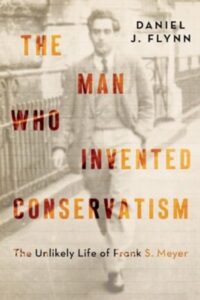
A primary vehicle by which fusionism helped forge and took hold of conservatism in the U.S. was National Review, about the founding funding plan for which we tried to recently draw some insights for philanthropy here, in the wake of Sam Tanenhaus’ new Buckley: The Life and the Revolution That Changed America.
“Meyer was present at the creation of” NR, “the biggest little magazine of the twentieth century,” according to Flynn’s The Man Who Invented Conservatism. At NR, Meyer “used his ‘Principles and Heresies’ column to act as the ideologist of the postwar right,” at the same time as “he created one of the greatest book sections of any magazine by attracting and cultivating talents, without much reference to politics or name recognition ….”
Philanthropy also makes significant appearances—from which a lesson or two could perhaps be drawn, as well—in Flynn’s biography of Meyer.
Communism
First, while studying anthropology at the London School of Economics in the early 1930s, for example, he benefited from Rockefeller Foundation support, Flynn notes. And later, when The “University of Chicago expelled Frank Meyer from its graduate school in 1938,” for another example, the John D. Rockefeller-founded “Chicago Workers School (CWS) promptly named him its director,” Flynn recounts.
In 1952, according to Flynn, the ex-Communist Meyer wrote to various foundations saying, “I have desisted from any writing on the Communist question so far …. But lately I have thinking of the possibility of doing a thorough job on an aspect of the Communist Party which has never been handled in any detail, so far as I know.” Flynn writes, “The pitch came amid a great appetite for anti-Communist literature,” though none of it yet included “a book detailing the aboveground party’s means and methods that produced the Communist cadre”—which Meyer justifiably felt qualified to provide.
Though he’d approached Henry Regnery with the proposal, Meyer’s “efforts concentrated less on publishers than foundations,” according to Flynn. “A man who had toiled for the party for over a decade for meager amounts wanted proper remuneration for recounting those labors.”
While nothing came of the Regnery approach, the RAND Corporation—after initially declining to provide any— provided some support. This support decreased, however, as any actual output from Meyer was delayed. While he completed a first draft of the book, its manuscript was rejected by The Free Press, after which RAND dropped its support and absorbed its losses.
That was it for the work, for the time being.
Conservatism
Then, “In early 1954, the William Volker Fund agreed to pay [Meyer] $1,000, and, more significantly, subscribe him to scores of scholarly journals, to act as a scout of sorts for the philanthropy,” according to Flynn. Volker himself was a Kansas City businessman and home-furnishing mogul who died in 1947. For the Volker Fund he endowed, Meyer was essentially a book reviewer before editing NR’s book section. “One of the talents Volker identified in Meyer’s reviewing scholarship was Meyer” himself.
Meyer “parlayed this relationship into stronger connections and more money,” Flynn writes.
He had petitioned Volker to award him a grant for a history of the United States from a libertarian perspective that he had begun as the 1940s transitioned to the 1950s coeval with the anti-Communist Democrat Meyer’s transformation into a right-wing Republican. Harold Luhnow, the nephew of the charity’s last namesake, informed him in July 1954 of $9,500 awarded toward the project.
The money validated Frank. His ego needed it less than his bank account.
Like Meyer, Luhnow “had experienced a political epiphany upon reading Friedrich Hayek’s Road to Serfdom,” Flynn continues. “Thus, Luhnow transformed a charity primarily aimed at uplifting Kansas City to one promoting liberty everywhere. Volker almost singlehandedly jumpstarted postwar libertarianism.” It supported the work of Hayek and Ludwig von Mises, and it helped launch the Mont Pelerin Society, the Foundation for Economic Education, and the Intercollegiate Society of Individualists. It paid for the lectures that later bound Milton Friedman’s Capitalism and Freedom, too. It was dissolved after Luhnow’s death in 1978, with its assets distributed to several charities and the Hoover Institution at Stanford University.
As Meyer began working for it, the Volker Fund “soon took intense notice of another of Meyer’s projects that eventually joined the auspicious list” of grantees like this, as Flynn tells it. The Freeman editor “Frank Chodorov, a bridge between the Old Right and the nascent conservative movement, recruited an enthusiastic Meyer to write a hit piece” in The Freeman “on the ideas of [Russell] Kirk and the New Conservatives,” as they were called, in Kirk’s The Conservative Mind. Meyer and Chodorov “stewed, explicitly over Kirk’s conception of conservatism that banished libertarians to the ideologue camp along with Marxists, bimetallists, and other cranks, and implicitly over his sudden renown.”
Meyer’s attention-getting and sharply critical piece, ominously entitled “Collectivism Rebaptized,” appeared in The Freeman in June 1955, merely months before the first issue of National Review. “Collectivism Rebaptized” raised a hackle or two—certainly one from Kirk, who called it “the Freeman folly,” Flynn reports. To Henry Regnery, Kirk “revealed that one of his moles had informed him that Chodorov had enlisted Meyer to write a book bashing Kirk as a collectivist authoritarian on the Volker Fund’s subsidy,” by Flynn’s telling. Flynn quotes Regnery as telling Kirk, “I don’t doubt that Chodorov is opposed to you and that he doesn’t like your point of view, but I rather doubt that the Volker Fund would subsidize anyone to write an attack on you.”
However, Flynn quotes Volker’s Luhnow as writing to Meyer—just as Meyer’s “Collectivism Rebaptized” was published: “The Directors of the Volker Fund have approved your request for a postponement of the one-year renewal of the grant for the book on American history” and “[w]e have acted favorably on your request for a grant of $4,750 for the preparation of a book on the New Conservatism during the next six months.”
It ended up taking longer than that.
“Rescuers” Rossiter and Regnery
In the meantime, in 1957, “one of the ‘new conservatives’ Meyer sought to excoriate with his Volker grant for” this book—Cornell historian and political scientist Clinton Rossiter—“rescued the moribund project” of Meyer’s previously contemplated book on Communism, according to Flynn. Rossiter had authored 1955’s Conservatism in America: The Thankless Persuasion, among his many books. “In response to Barry Goldwater’s presidential campaign” about a decade later, Joshua Tait notes in The Bulwark in 2021, “the painfully moderate Rossiter had chosen sides. He rebuked his association with conservatism—now identified with Goldwater—in Time magazine. ‘I am not now and never have been a conservative,’ Rossiter announced.” (Link in original.)
The Ford Foundation-supported Fund for the Republic, for which Rossiter served as general editor a landmark series on “Communism in American Life” that featured books by authors “outside of Communism but not on the right, allotted $4,000, and $500 for expenses, for the roster’s political oddball”—Meyer—to complete the book. “The money injected adrenaline, albeit not enough to put the project over the finish line.”
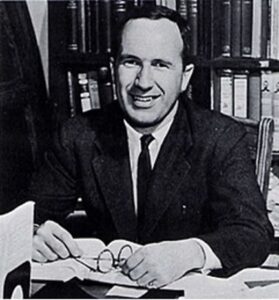
Clinton Rossiter
Overall, the “Communism in American Life” series addressed the nature and impact of communism in the United States, specifically including what some of its contributions considered the damaging effects of anti-communist McCarthyism on society and civil rights. Some on the right deemed it “un-American.”
Rossiter and the publisher of this particular book on Communism by Meyer—“the short-lived Harcourt, Brace & World moniker,” as Flynn puts it—gave Meyer time to complete it as he was also working on the other, New Conservatism book. Interestingly, this Volker-funded work of Meyer’s on conservatism, the one which grew out of his anti-Kirk “Collectivism Rebaptized” Freeman article, was also “rescued”—also interestingly, and perhaps quizzically to right-wingers, by “Kirk’s longtime collaborator Henry Regnery,” as Flynn characterizes him.
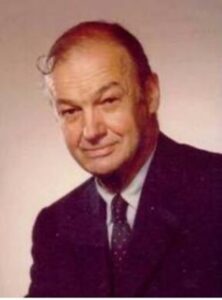
Henry Regnery
Kirk and Regnery had a messy falling out in 1959. “Convinced that Regnery’s ‘sharply’ breaking with Kirk fueled an almost vindictive interest in publishing his book” on conservatism, according to Flynn, “Meyer vowed to prioritize it after finishing” the one on Communism.
“In February 1960, Meyer signed a contract with the Henry Regnery Company” for the conservatism book, Flynn writes. “The Chicago publisher advanced him $250, just less then he made for a speech and a tiny fraction of Volker’s grants that had poured into the project since 1955.”
Results
Meyer’s momentous The Moulding of Communists: The Training of the Communist Cadre, finally was published in 1961. Its audience, “right-wingers, looked quizzically upon the involvement of the Ford Foundation-bankrolled Fund for the Republic,” according to Flynn. “This, however, coaxed publications that might normally overlook such a release to review it.”
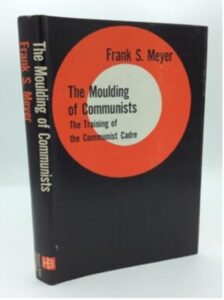
Then, with Meyer’s promised subsequent conservatism book, his “pattern of missed deadlines repeated,” Flynn writes. “So much time had passed from 1955 seed to 1962 harvest that Meyer received notification in early 1962 of the Volker Fund’s termination based upon the wishes of its long-deceased founder.”
The resulting “delay proved convenient,” Flynn notes, as it allowed time for the work to relatively quickly change from the originally conceived “invitation to a no-liberals-welcome rumble” to the unifying, Big Idea argument for a fusionist conservatism in the also-momentous In Defense of Freedom: A Conservative Credo, finally published later in ’62.
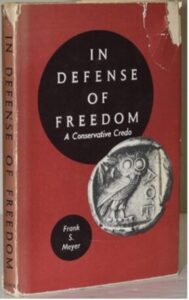
Public opinion had “shifted away from Kirk’s conception of conservatism and toward the one embraced by National Review,” as Flynn describes it.
By the early 1960s, a harsh critique like the Freeman broadside, if devouring a whole book, might look like a non sequitur at best and at worst literary bullying. Meyer, too, had not only softened toward Kirk but moved, albeit by inches and not yards, in his direction. The book certainly critiqued European-style conservatives. It developed into something less parochial and more ambitious. One message pervades its 172 pages: This is what we believe.
Flynn overviews the movement-shaping beliefs presented in the book by Meyer, who died in 1972 at the age of 62:
In Defense of Freedom advances individual rights, freedom and a government dedicated to the preservation of both. And therein lies the fusionism. Americans find freedom in their tradition. Preserve the latter and one preserves the former. Fusionism brought traditionalists and libertarians together. Critics found this to be a contrived unity that allowed the right to paper over internal differences. Meyer regarded it as an organic political philosophy growing out of history. And that allowed him to more firmly root fusionism within conservatism because he could show that it came from somewhere and rather than from someone. America did not tether its identity to a monarch or a sect or an ethnicity but to its founding credo: freedom.
Redefinition and Re-examination
Michael Lind fairly characterizes postwar Meyer’s as “[o]ld-fashioned conservative ‘fusionism’” in a 2023 Tablet article. It is “a synthesis of anti-communism, moderate free market economics, and the genteel traditionalism represented by Russell Kirk,” he writes.
Many have equated the philosophical synthesis of fusionism with Cold Warrior Ronald Reagan’s oft-cited subsequent metaphor of a “three-legged stool” of conservatism, with each leg representing a faction in a coalition—anti-Communism, libertarian free-market economics, and traditional social or “family” values, often anchored in religion. Meyer’s fusionism is a rigorous intellectual framework, some reasonably point out, while Reagan’s “stool” is a taxonomy that describes what was a political coalition, one that had a political purpose and achieved political success.
Knowingly risking oversimplification: during the post-Cold War rise of populist objection to elite institutions and governance, and as conservatism itself is being either greatly refined or outright redefined, fusionism itself is being explicitly and implicitly questioned and re-examined. Certainly, one if not two of the old “stool’s” legs/factions are wondering whether they were ever getting an even third of the benefit of holding it up. To them, something of a coalitional re-negotiation is warranted, if it hasn’t already electorally happened.
Fusionism as a philosophical framework may be timeless. Perhaps, it can survive if morphed or updated or applied in a new historical context, a “new fusionism” that might then be accorded or even earn the status of New Fusionism. Or maybe it just had a hell of a run and should be congratulatorily recognized and recorded in the history of conservatism and America. Others can, and should, argue.
Scale
At minimum, even if fusionism “only” had a hell of a run, it was a decades-long, successful run—and offers some insights for philanthropy that its current practitioners should understand and from which, if they do, they could benefit. Two of them regard scales of measurement, and two others regard the scope of grantmaking options for consideration.
The measurement scales at issue here are time and impact. On time, lengthen it. Meyer first proposed what became The Moulding of Communists in 1952, and it wasn’t published until 1961. Volker’s first grant for what became In Defense of Freedom was awarded in 1955, and it wasn’t published until 1962. In each case, both the philanthropies’ and publishers’ patience was well-warranted, albeit perhaps right along with their justified frustration.
While maybe not impossible, it’s difficult to think of contemporary “strategic” philanthropy putting up with deadline extensions measured on the order of years like this. Required, quantitatively “provable” “returns on investment” for proud inclusion in quarterly or annual reports to the board and grantor executives are in too much tension with “works in progress” at this slower, quite-deliberative pace of Meyer’s. Measured or not, the delays were probably worth it, qualitatively.
In evaluating impact, moreover, bring data-skeptic common sense—which is related to having a longer and forward-looking worldview. “The Moulding of Communists, an inferior book read only as a curio if at all decades later, outsold [the] initial run of In Defense of Freedom within a few months of its release. As a commercial endeavor, In Defense of Freedom flopped,” according to Flynn. “In terms of influence, it succeeded wildly.”
Scope
On the scope of grantmaking options for consideration, widen it—to include some from what might oversimplistically be considered the “other side” of one’s own philosophical or ideological worldview. Meyer was an intellectual refugee from Communism, but the libertarian Volker Fund nonetheless saw value in that which he had to offer, including to it and then-ongoing debate about conservatism. He was also the “political oddball” that Rossiter saw fit to include on his Ford-funded Fund for the Republic roster of authors about that same Communism’s history and modes of operation.
While maybe not impossible, it’s hard to think of contemporary philanthropy considering an idea outlier like Meyer for support. Someone from the “other side”—not on “our team”—and thus not to be trusted, much less funded. Someone capable of mind-changing or having “second thoughts.” He’s either had or still has important disagreements with us, after all, on other discrete elements of our mission, our vision, our aims, our vibe … our party? The “other-side” giving was beneficial, in each case here—by Volker to the old Red, whose thinking beneficially reflected it in In Defense of Freedom, and by Rossiter and the Fund for the Republic to the same old actual onetime Red, whose thinking and experience benefited from such in The Moulding of Communists.
Both the funders and publishers of each of these books, again moreover, were aware of the funders and publishers of Meyer’s other, basically contemporaneous book. Given these funders’ profiles, try contemplating a similar sort of co-funding happening today. Each funder likely would be an internal obstacle or barrier to getting support from the other, to great detriment.
Fear not “other-side” giving; actually, intelligently engage in it. Given the involvement of human beings, there is almost always a debate going on over there. Feel free to foster it. There’s one happening now, and it will be ongoing. Nor fret about debates within one, “your”—our—side either, as is also happening now and will be ongoing.
Meyer didn’t. In fact, find and fund more Meyers and those like him. They’re out there, now, smartly and sometimes sharply questioning and re-examining. Uncomfortably to some.
“The money injected adrenaline,” as Flynn writes in The Man Who Invented Conservatism, recall. There would be benefit.
This article first appeared in the Giving Review on July 29, 2025.














